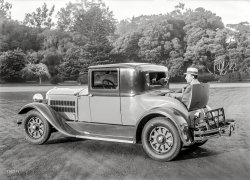
MAY CONTAIN NUTS

Search Shorpy
SHORPY ART

Framed or unframed, desk size to sofa size, printed by us in Arizona and Alabama since 2007. Explore now.
Join and Share
Ad-Free Shorpy
Shorpy is funded by you. Patreon contributors get an ad-free experience.
Learn more.

Recent comments
- Ticket Retention
- Killed by Amtrak
- Back to the Future
- Heckuva remote control!
- Sometimes — Things Go Bump!
- I SEE THE LIGHT
- Union Switch and Signal Company
- Get That Light Out Of My Eyes
- Eggs. Eggs. Eggs. The Egg Man is Here!
- Foreboding caption
- Famous Hollywood faces
- Not just S&P
- re: Those things in the jar
- Up In Smoke
- Medical Smoking
- Quick fix
- A Quink Comment
- If You’re Like Me, Never
- Delivering the News
- U.S.A.
- S&P
- 1940 Zenith radio model 6G601
- Quality goes in before the name goes on!
- Snazzy skirt
- Carbon Arc Lamps
- Illuminate us
- I remember it well
- I can't prove it
- Complicated then, forgotten now
- Bryan-Stevenson
Member Photos
The Shorpy
Print Emporium
Print Emporium
Search Shorpy
Search results -- 30 results per page
- Man on the Moon: 1920
- ... go to http://mooncars.wordpress.com .
(The Gallery, Cars, Trucks, Buses, Chris Helin, San Francisco) ... Posted by Dave - 02/24/2017 - 1:27pm -
![Man on the Moon: 1920 San Francisco circa 1920. "Moon auto." Its virtues being demonstrated in front of the building also seen here and here. Latest heavenly body in the Shorpy Orrery of Automotive Astronomy. 5x7 glass negative by Chris Helin. View full size.
Jerry Built"Moonbeam" headlamps.
[With Macbeth-Evans "Liberty Lenses." - Dave]
Moons of St. LouisI became interested in Moon automobiles while researching my wife's family history. I came across three photo's of a Moon coupe One of them shows my wife's great-grandmother standing next to a son-in-laws's Moon Coupe in Minneapolis in 1923 or 1924.
For more on Moon Motor Car Company go to http://mooncars.wordpress.com.
(The Gallery, Cars, Trucks, Buses, Chris Helin, San Francisco)](https://www.shorpy.com/files/images/SHORPY-1093.thumbnail.jpg)
- Pharmacy Alfresco: 1940
- ... and feel better fast with Goshert!
(The Gallery, Cars, Trucks, Buses, M.P. Wolcott, Stores & Markets) ... Posted by Dave - 06/17/2017 - 8:58am -
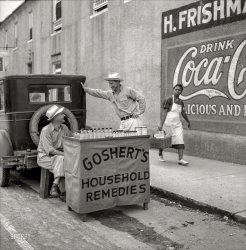
- Electro-Motive: 1943
- ... booster 1A.
Brake wheels Brake wheels on freight cars were for many years in the horizontal position like this one, on the car ... this photo. For years, brakemen rode the tops of freight cars during yard switching procedures. This practice was outlawed for sound ... Posted by Dave - 03/11/2015 - 11:21am -
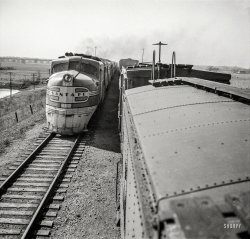
- The Greats: 1955
- ... Axelsson was my uncle.
(ShorpyBlog, Member Gallery, Cars, Trucks, Buses) ... Posted by lara - 09/16/2011 - 5:26pm -
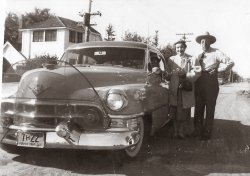
- Skillet Worker: 1940
- ...
(The Gallery, Camping, Cars, Trucks, Buses, M.P. Wolcott) ... Posted by Dave - 07/25/2019 - 5:47pm -
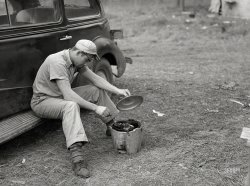
- Shelbyville: 1938
- ... 35mm nitrate negative by John Vachon.
(The Gallery, Cars, Trucks, Buses, John Vachon, Railroads) ... Posted by Dave - 09/08/2011 - 12:57pm -
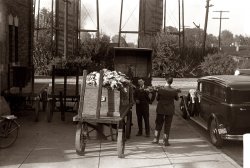
- Erie 2601
- ... Sunday night. It was pulling a train of about eighty cars and was running along at a fairly good rate of speed when suddenly it left ... Posted by Lost World - 09/22/2011 - 11:39pm -
![Erie 2601 Erie 0-8-8-0 Camelback locomotive at Port Jervis, N.Y., in 1911. The camelback design was unique in that the engineer sat in the tiny cab alongside the boiler, while the fireman worked at the usual spot behind the boiler. One of the main disadvantages was the obvious communication problem between engineer and the rest of the train crew while the engine was in operation. The Erie camelback mallets didn't last long, but smaller camelback locomotives survived well into the 1950's on roads like the Jersey Central. View full size.
Photo's History?What might you know of the photo's history? Interesting shot of a very rare locomotive.
Don Hall
Yreka, CA
Erie 0-8-8-0 CamelbackAt Port Jervis, N.Y., in 1911.I model trains in HO scale. I have never seen anything like this engine. I have seen 0-4-0, 0-6-0 and 0-8-0 camel engines, but never an articulated camel. I have a 2-6-6-2 articulated and have seen the 4-8-8-4 UP engines, but not this one. Anyone know where I could get more pictures of this engine?
Don Rowland - donhotrains@cinci.rr.com
[You could try contacting the person who posted this picture. First sign up for a user account, log in, click on his username, and then "contact." - Dave]
Erie 0-8-8-0 malletThe "Mother Hubbards," sometimes called "camelbacks", common on railroads in the Anthricite (hard coal) region of Pennsylvania. IIRC there weren't many articulated locomotives built this way. I believe this particular type of locomotive was typically used in "helper service," pushing coal trains over the mountains.
The design comes from the need for a very large firebox on locomotives burning hard coal. Hard coal required a fairly thin fire to burn well, thus a large area was required to burn the amount of fuel required to generate enough steam. The fact that they burned the lowest quality of coal available didn't help!
This particular locomotive is interesting in that it is a true compound; notice the size of the front low pressure cylinders compared to the high pressure cylinders on the rear engine. This makes it a "true" Mallet.
It turned out that compounding didn't work as well as expected on railroad locomotives, and later articulated locomotives were built as "simple" engines.
I've never seen any of the larger Mother Hubbards in service, but I did see several of the smaller 0-6-0s and 0-4-0s in active service.
BTW & FWIW - in the 70's we lived in McCloud for four years. Beautiful country in that end of the state!
Erie 0-8-8-0- More photos (Link)There are a few more photos of these engines at:
http://www.rr-fallenflags.org/el/loco/erie-lmn.html
Erie Engine No. 2601 Derailed at Gulf SummitIn my wife's hometown paper (The Deposit Courier), the "Looking Back" section "100 Years Ago, 12 October 1910" says, "Erie engine No. 2,601, one of the largest engines in the world, was derailed at Gulf Summit Sunday night. It was pulling a train of about eighty cars and was running along at a fairly good rate of speed when suddenly it left the track. The big engine pounded along the rails for about 500 yards, cutting off the ends of the ties and tearing up the roadbed for a considerable distance. The Susquehanna wrecking crew was called and repaired the damage."
Only oneThere was only one of this type of locomotive ever built, and it was used for only one thing. Hump work. Basically this engine spent its whole life pushing long trains up the hump of a yard where they would be gravity sorted. The idea behind the placement of the cab was more for visibility than anything. As for communication, the engineer and fireman used their own whistles to communicate between themselves. The engineer used the train whistle, the fireman had a lighter, lower whistle he used.
There were three of theseThere were three of these used for pusher service, not hump service. Only the ERIE had articulated camelbacks, no other road had them. They were all rebuilt later with their cabs at the back.
There were alot of camelbacks in the east and even some western roads had them: Santa Fe, Canadian Pacific, MKT, Chicago & Indiana Coalm, C&IE, to name a few.
There are more pictures all over the Internet, even a color painting.
An HO scale model just sold on Ebay for over $3000.00!
(ShorpyBlog, Member Gallery, Railroads)](https://www.shorpy.com/files/images/erie.thumbnail.jpg)
- Texas 1939
- ... 35mm nitrate negative by Russell Lee.
(The Gallery, Cars, Trucks, Buses, Russell Lee, Stores & Markets) ... Posted by Dave - 02/09/2008 - 2:34am -
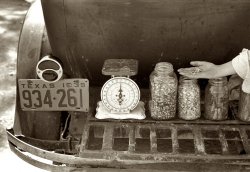
- Red Light and Siren: 1963
- ... View Larger Map
(ShorpyBlog, Member Gallery, Cars, Trucks, Buses, tterrapix) ... Posted by tterrace - 06/24/2009 - 5:01pm -
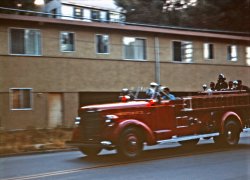
- On Time All the Time: 1921
- ... little history of Frederick, Maryland
(The Gallery, Cars, Trucks, Buses, Natl Photo, Patriotic) ... Posted by Dave - 07/04/2019 - 9:17am -
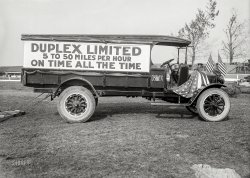
- Proviso South: 1942
- ... to special handling.
Somebody kept track of those cars at all times.
In the foreground appears to be a program to rehab a batch of old passenger train insulated milk cars (note the express trucks, more visible in another shot apparently in the ... Posted by Dave - 08/30/2012 - 12:01pm -
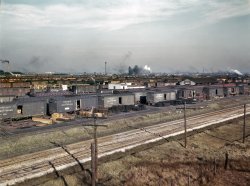
- Sunshine Laundry: 1920
- ... than in all the photos I had seen. Why?
(The Gallery, Cars, Trucks, Buses, D.C., Natl Photo) ... Posted by Dave - 09/12/2011 - 1:20pm -
![Sunshine Laundry: 1920 Washington circa 1920. "Sunshine Laundry." The new plant of the Arcade Laundry and Sunshine Dry Cleaning and Dyeing Co. on Lamont Street N.W. National Photo Company Collection glass negative. View full size.
Eternal Sunshine.Much to my surprise, the building is still there, and still looking pretty much the same.
View Larger Map
LOTWThose buildings are now the corporate headquarters of a commercial linen service called Linens of the Week.
No Injurious Wringers
Seeing Is Believing
Every Washington housewife is invited to inspect
the cleanest, largest, and sunniest and most scientific
establishment for laundrying, cleaning and dyeing
clothes in America - right in our own city.
The Arcade Laundry and
Sunshine Dry Cleaning & Dyeing Co. Inc.
The Arcade Laundry and Sunshine Dry Cleaning & Dyeing Co., is such an institution, the largest of its line in the city and one of the largest in America.
...
We want you to see and inspect the plant. We want you to see for yourself the mammoth tanks where 55,000 gallons of water are softened each day, so that every lot of clothes is washed without rubbing in 700 gallons of water as soft as rain water, with seven changes of water to each lot.
You will be interested in the Mending Department, where all minor repairs are made without extra charge; the Individual Net Bags, where Handkerchiefs, Fine Waists, and Fancy Linens are protected; the Collar Ironers where even the edges are ironed, eliminating all roughness, the Clothes Extractors, which have replaced the injurious wringers.
...
You will see the finest of Silk Shirts, Dainty and Lacey Underwear being carefully Ironed by Electric Hand Irons.
...
In the Department of Dry Cleaning we will show you the plant for Naphtha Distilling, removing all grease and oil from naphtha and gasoline before being used. You will see the Spotting Department, where all spots are removed by experts, each spot requiring different treatment, so as not to injure the fabric.
...
The Special Room for Dyeing is always of interest. Here Outer Apparel of all kinds is dyed by our Guaranteed Process, without injury, even Rugs and Carpets, where colors are faded, can be made to look like new by a change in shade.
A feature of the Dyeing Department is made of a Special Emergency 24-Hour Mourning Service. Families or individuals needing such service will have our undivided attention with every facility of this department at their disposal to prevent disappointment.
Advertisement, Washington Post, Nov 20, 1921
Outside the Plant"We want you to see and inspect the plant." Thus saith management, but if those invited housewives showed up, they might have had a few words to say about the plant yard.
[The plant hasn't opened yet -- it's still under construction. - Dave]
I must say that, as much as I appreciate the various landmarks of classical D.C. architecture Shorpy shows us, these old industrial buildings and plants are a special treat.
A matter of ScaleA question for photo experts: Why do these old photographs convey a much larger sense of scale than their modern-day equivalent? For example, when you look at Google street view of the Sunshine Laundry, the environment seems much smaller and more congested than the 1920 photo. I've noticed this with real life in-person comparisons as well; the first time I visited the Golden Gate bridge it seemed much smaller than in all the photos I had seen. Why?
(The Gallery, Cars, Trucks, Buses, D.C., Natl Photo)](https://www.shorpy.com/files/images/29018u_0.thumbnail.jpg)
- Fire Truck: 1950
- ... when I hear Big Bad John by Jimmy Dean.
(The Gallery, Cars, Trucks, Buses, Fires, Floods etc., News Photo Archive) ... Posted by Dave - 04/29/2017 - 8:06pm -
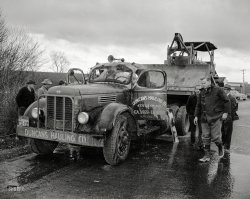
- Backslider: 1935
- ... Balloons on the brand new Studebaker.
(The Gallery, Cars, Trucks, Buses, San Francisco, W. Stanley) ... Posted by Dave - 08/19/2018 - 11:32am -
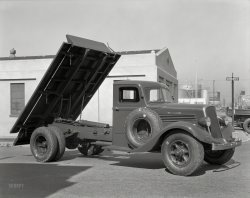
- Model Tee: 1928
- ... there any of people actually playing?
(The Gallery, Cars, Trucks, Buses, Chris Helin, San Francisco, Sports) ... Posted by Dave - 07/05/2017 - 9:13pm -
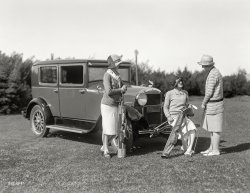
- A Diamond for Lil: 1959
- ... large guy wire cutters (bolt cutters).
(The Gallery, Cars, Trucks, Buses, Gottscho-Schleisner) ... Posted by Dave - 03/10/2014 - 7:28am -
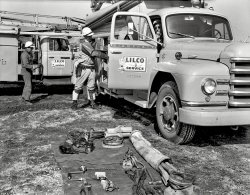
- 1948 Hudson Again
- ... View full size.
(ShorpyBlog, Member Gallery, Cars, Trucks, Buses, tterrapix) ... Posted by tterrace - 11/27/2017 - 1:30pm -
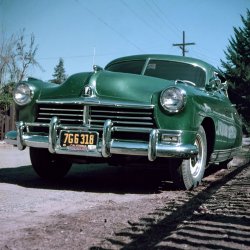
- Market Movers: 1910
- ... Of the Men Must Wear a Hat law.
(The Gallery, Cars, Trucks, Buses, DPC, NYC, Stores & Markets) ... Posted by Dave - 04/28/2015 - 7:37pm -
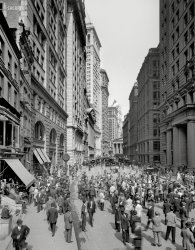
- Shampoo: 1937
- ... tackle if the pole wasn't straight.
(The Gallery, Cars, Trucks, Buses, D.C., Theodor Horydczak) ... Posted by Dave - 02/18/2014 - 11:40am -
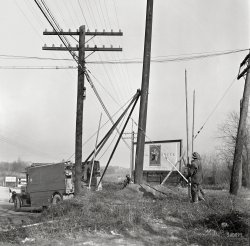
- Peerless and Poised: 1920
- ... height is the same as your 'wing span'.
(The Gallery, Cars, Trucks, Buses, Chris Helin) ... Posted by Dave - 11/17/2014 - 3:24pm -
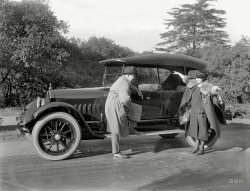
- Queen Cole: 1920
- ...
They look like they could be sisters.
(The Gallery, Cars, Trucks, Buses, Chris Helin, San Francisco) ... Posted by Dave - 10/23/2016 - 3:38pm -
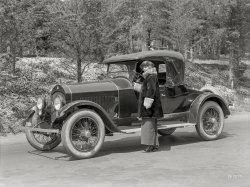
- Mr. Right: 1920
- ... poles are survivors of the 1915 fair.
(The Gallery, Cars, Trucks, Buses, Chris Helin, San Francisco) ... Posted by Dave - 10/21/2014 - 1:00pm -
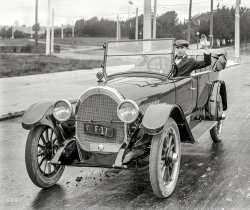
- Fiber to Fabric: 1941
- ... that look similar, but this one matches.
(The Gallery, Cars, Trucks, Buses, Factories, Jack Delano) ... Posted by Dave - 09/28/2019 - 3:47pm -
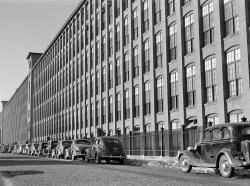
- The Ubiquitous Banana: 1920
- ... confusion with International Harvester.
(The Gallery, Cars, Trucks, Buses, D.C., Natl Photo, Stores & Markets) ... Posted by Dave - 10/10/2016 - 8:52pm -
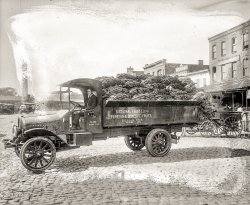
- Shady Six: 1925
- ... to sit still for the photo!
(The Gallery, Cars, Trucks, Buses, Chris Helin, San Francisco) ... Posted by Dave - 06/13/2017 - 11:59am -
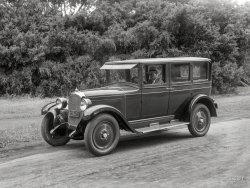
- Cave of the Winds: 1963
- ... Cadillacs generally advertised as eight- or nine-passenger cars? - Dave]
You're right. They were 8 or 9 passenger cars. I don't know what I was thinking. I should get the thing finished and ... Posted by K. McCool - 08/02/2018 - 7:51pm -
![Cave of the Winds: 1963 June 1963. A tourist stop in Manitou Springs, Colorado, with mineral water springs and all the usual "souvenirs." Captured on 35mm Kodachrome by my great-uncle Herbert F. Krahn of Oshkosh, Wisconsin. View full size.
Oh GoogleFunny that Google automatically blurred out the face of the statue of the Indian chief in the Google Maps picture, to protect the privacy of the statue, I guess!
The Trading Post and the Mineral SpringIf you zoom out a little and view to the right on the Google Map posted by John Howard, you can see the remains of the Trading Post souvenir shop and the statue of the Ute Chief that dispensed the spring water. Here's what they looked like in 1963.
The charm is missingAt some point, the road less travelled was given an arch less inspiring.
That's a 1953 Cadillac FleetwoodSeven-passenger series 75 in the foreground. I have the same model in a '51 which I've been trying to restore for 24 years. In the background is a 1960 Mercury, or there's a slight outside chance it could be a 1960 Canadian Monarch. If only I could read the script on the right rear fender. Both are magnificent automobiles.
[The Mercury is a Monterey. The 1960 Monarch had different taillight lenses and a crown on the trunk lid. And weren't Series 75 Cadillacs generally advertised as eight- or nine-passenger cars? - Dave]
You're right. They were 8 or 9 passenger cars. I don't know what I was thinking. I should get the thing finished and drive it.
Not the best purchaseMy father bought that exact white 1960 Mercury Monterey new when I was 18. A huge slow beast based on the Lincoln unibody. Not a teenager's favorite, to say the least.
[Mercurys of this era used body-and frame construction and were not based on the unit-body Lincolns. - Dave]
A matter of tasteMy father had a 1960 Mercury Monterey just like this, even the same color. It was about 4 years old by the time he acquired it. My brother and I thought it about the ugliest car ever built. I have to admit I still feel pretty much the same over 50 years later. I guess it's a matter of taste though, my father liked it, as he did just about anything else built by Ford.
Was There, ThenI could have been riding by when this picture was taken. I was 5 and in the back of one of my dad's cherished Buicks, reading Scholastic Books that kindly teacher Mrs. Hanks had loaned me for the long trip from Ohio. I had some Silver Surfer and Sgt. Rock comics that I read over and over too, often sitting on the floor in the back in a tent made of a beach towel held up by tucking the edge behind my parents' backs. Dad had a job interview in Denver, so he and Mom made a trip out of it. We also drove through the Black Hills and Mount Rushmore on that trip. I remember the pine smell and the friendly chipmunks. He didn't get the job.
(ShorpyBlog, Member Gallery)](https://www.shorpy.com/files/images/CaveOfTheWinds.thumbnail.jpg)
- Conductor Cunningham: 1943
- ... Cunningham telephones his yardmaster with the number of cars he has to handle and where the delivery is to be made." Medium-format ... Posted by Dave - 08/30/2016 - 10:36am -
![Conductor Cunningham: 1943 January 1943. "Freight operations on the Indiana Harbor Belt railroad between Chicago and Hammond, Indiana. Getting his waybills, Conductor Cunningham telephones his yardmaster with the number of cars he has to handle and where the delivery is to be made." Medium-format negative by Jack Delano for the Office of War Information. View full size.
Poster in the upper rightBuy Bonds! Win the War!
oh REAL-ly@Kcamp I know Adolph Treidler worked out of New York, but when he made that poster he must have been using a reference photo from the Norfolk & Western, because that's one of the better portraits of a Y6 Class I've seen, in the foreground.
Paper rolled into cylindersI wonder what the function was for the paper rolled into cylinders in front?
[I'd say print-outs of previous schedules, bundled for convenient storage. -tterrace]
Also, you never see anything with scissor extensions anymore, they're the most steampunk thing ever.
American ingenuity at workCoffee can used as a lampshade. Gotta love that.
Poster in Upper LeftAdolph Treidler poster from the early 1940s.
I like my coffee lightA pot light made from a coffee can (from 1943) will look great hanging over any kitchen island. Going to add it to my list of options.
Blue IslandChances are good the location is the Blue Island yard office. The rolled paper looks like stored train lists that came over teletype machines. Notice the two tubes (left side of image) that carried waybills, train lists and such over the pneumatic tube system to various offices within the yard.
Gibson in Hammond Indianamight also be where this pic was taken. The IHB had their main offices located there, along with a big hump (Classification) yard.
The Indiana Harbor Belt at Gibson is where the billing offices processed and mailed out their accounts payable.
Tube jobLove pics having anything to do with the 40's and trains. The pneumatic tubes remind me of a summer job I had once at a large wholesaler. I worked the central tube room and distributed the tubes to stations all over the building. Fun job and the learning curve was a straight line.
(The Gallery, Jack Delano, Railroads)](https://www.shorpy.com/files/images/SHORPY-8d24289a.thumbnail.jpg)
- High Spirits: 1956
- ... or hideous, but the chance to see happy people, great old cars, wonderful clothes, high-waisted trousers and full-fashion hosiery-with ... Posted by Dave - 06/16/2012 - 4:14am -
![High Spirits: 1956 Southern California circa 1956. The Oldsmobile and Mrs. Binoculars are back! Everyone seems to be in a jolly mood. 35mm Kodachrome. View full size.
Rhapsody in BlueLove them wide whitewalls and bosomy bumper guards!
How do they end up on eBay??Love the blue and pink dress in the middle!
Dave, do you think people toss or hand off their slides because they've converted them to dvd's? I simply can't believe that no one in a large family would take charge of the slides, for privacy's sake if nothing else. Perhaps they tell the conversion business to dispose of them and they end up on eBay? I find this really strange when there clearly are other family members or friends in these images. Families usually go through deceased members' belongings to share/divvy up what is there. House clearance sales are usually for people with uninterested family, or for loners, aren't they? What do you think?
Thanks for this amazing site. Between yours and Retronaut, I end up spending hours in old memories of my life in the States quite often.
Gail in Kent, England
[Someone dies, and then there's an estate sale. That's how most of these end up on eBay. - Dave]
About that beltlineIt's hard to believe now, but high-waisted pants were considered hip in some parts of the LA scene in the '56-58 era. Dick Contino's fashion choice in this much-mocked excerpt from "Daddy-O" (1958) shows it wasn't limited to kids whose mamas dressed them funny.
Zoot SuitIndeed the high waist and baggy legs were considered high style starting in the 1930's. Movies from that period commonly show pants worn well above the elbows -- with varying states of bagginess.
The kid looks like he was the inspiration for the 'Urkel' TV character.
Glad they ended up on eBayIt is sad that there was apparently no one left to cherish these photos, but 60 or so years can work a lot of changes within a family. I'm glad these made it onto Shorpy. It might be different if they were laughable or hideous, but the chance to see happy people, great old cars, wonderful clothes, high-waisted trousers and full-fashion hosiery-with the seams, makes their appearance here a fitting memorial to this lovely group of folks.
Good TimesI agree with Bull City Boy that Shorpy readers are the benefactors of these delightful photos which present to us historically accurate and joyful times in the lives of this particular group of amicable friends. These are real moments in time preserved for future reference and even the personalities of the characters express themselves through body language, laughter, shared jokes and revealed joy. The little boy with both belt and suspenders (and grass stains on his knees) tells us he is all boy, but very disciplined in being the only one to stand at attention while posing for the picture. The lady with the flowered dress is sharing a humorous thought and amusing her friends. The turned-around lady and girl on the extreme left are looking for something they have misplaced. Everybody has a story, but rarely is it captured for all eternity in a permanent etching. I'm lovin' this group of pictures because in my lifetime the fabulous fifties stands out as the best of times. It is so much better than having them stashed in a shoebox and forgotten at the bottom of someone's closet, like a gift that keeps on giving. Thank you Shorpy for stirring some spectacular memories.
Keep 'em coming.I come to Shorpy for the older photos however I can not remember the last time I enjoyed a set of photos as much as I do these. I'll echo the sentiment that it is tragic that nobody from the family could have kept these. Thanks for letting us see them.
What gets them on eBayPeople die and the ones who inherit the photos don't know any of the people in the photographs, so the emotional tie is broken. Maybe they keep them for a while but then they move, or downsize, or get a little paranoid that they're a little like those people on the hoarder TV shows. Anyway, the person who is in charge of getting rid of the stuff decides that they'll try selling the slides instead of dumping them in the garbage because he's heard that there are people who collect old slides, and the few bucks he'll get for selling them might come in handy some day.
[Actually how it works is you hire someone to dispose of the contents of the house and don't even look at the slides, or you just toss the contents of that closet in a Dumpster somewhere. I've helped clean out the houses of various deceased relatives, and there was no careful inspection of the zillion items that had to be gotten rid of before the house could go on the market. We certainly weren't looking at slides. That kind of stuff just went in the trash. Dozens of Kodak Carousel boxes from my grandmother's house, for instance, containing what must have been thousands of slides. They took up an entire closet wall. - Dave]
I feel like I know this family!I am so glad we got to see glimpses into the life of this wonderful family. Thanks for posting this series of photos!
I wantthe satin dress on the right and the shiny Olds!
(SoCal 1956 Kodachromes)](https://www.shorpy.com/files/images/SHORPY_SoCal_Olds_ladies.thumbnail.jpg)
- Breuner's Furniture: 1919
- ... dreams were made of, back in the day.
(The Gallery, Cars, Trucks, Buses, Chris Helin, San Francisco) ... Posted by Dave - 06/26/2015 - 12:46am -
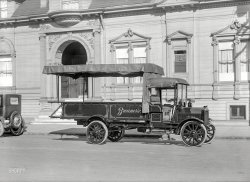
- Ready to Rumble: 1928
- ... long as you keep the rumble seat closed.
(The Gallery, Cars, Trucks, Buses, Chris Helin, San Francisco) ... Posted by Dave - 10/12/2014 - 7:28pm -
